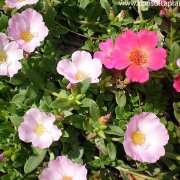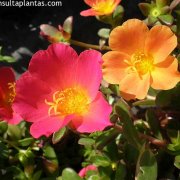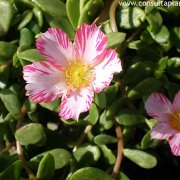Care of the plant Portulaca oleracea or Common purslane |
|
The genus Portulaca, family Portulacaceae, includes more than 50 species of annual and perennial herbaceous plants native to tropical and temperate regions of all continents. Some species are: Portulaca oleracea, Portulaca umbraticola, Portulaca grandiflora, Portulaca quadrifida, Portulaca lutea, Portulaca bicolor. Common names: Common purslane, Duckweed, Little hogweed, Pursley. This species is native to Asia and southern Europe. They are annual herbaceous plants with a creeping bearing and reddish stems that reach 40 cm (15.74") in height. The leaves are succulent and more or less spatulate. The decorative flowers are up to 2.5 cm (098") in diameter and can be red, yellow, orange, pink or white. They bloom in summer. The flowers open on hot, sunny days from mid-morning to early afternoon. The fruits are small capsules that open releasing the seeds. Common purslane is used as annual plants in rockeries, on borders, in mixed borders and in hanging pots for patios, terraces and balconies. The leaves and stems can be eaten in salads and soups. Portulaca oleracea needs full sun exposure and a warm climate. Duckweed grows in any type of soil but prefer well-drained soils that contain a little organic matter. Water regularly waiting until the substrate has almost dried. Little hogweed resists a few days of drought. Fertilize in summer every 15 days with mineral fertilizer. Common purslane does not need pruning. Portulaca oleracea is a quite resistant plant to pests and diseases that can be attacked by snails and some insects. Duckweed is propagated from seeds sown in spring directly to their final location. |
Images of the plant Portulaca oleracea or Common purslane |
Find plants
Portulaca oleracea or Common purslane | Care and Growing
© 2025 FavThemes



